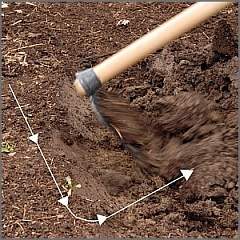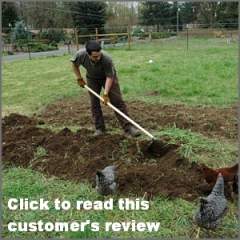How to use a Grub Hoe
Author: Greg Baka
A grub hoe (also called a grubbing hoe) is primarily used to dig and till the soil. It will chop through sod to break it up and allow removal. It will also work in both firm and soft soil. In soft soil it is usually just used for tilling (mixing) the soil. In firm soil it can be used to break the ground for creating a new garden, or to loosen and drag soil away for tasks like planting trees or installing sidewalks. It can even be used for digging deep narrow trenches.
Click here to see pricing and sizes:
Digging and Tilling
Using a grubbing hoe (also called an Azada) is very different from using a shovel or spade. Instead of stomping or ramming a shovel blade into the earth, the heavy-duty hoe blade swings from hip height down into the soil using it's own weight, gravity, and a little help from your arms. Instead of leaning over to lift the shovel load of soil with your back, with the long-handled grubbing hoe you use your whole body to pull the thin slice of soil towards you into a previously cleared space.
Think of it this way... you can use a shovel to move a single 4 lb chunk of soil, or you can use two quick strokes of the hoe to move two 2 lb slices of soil - with less strain, less pain, and in less time! It is the easy way to dig!


How to Use: Proper Grip and Action

Figure 1.
2. One hand goes at the very end of the handle, the other hand goes 1/3 of the way down the handle (see Figure 1).
3. Grip the handle with your thumbs facing towards the blade. This is important.
4. Raise the tool to hip or chest height and chop it down into the soil, then pull the slice of soil back towards you. (read the "Digging and Tilling" section above)
5. Walk forward as you till. This is the opposite of shoveling or spading, where you walk backwards. Think of using grub hoes as a human-powered rototiller - you keep walking forward, chopping and stirring up fresh ground. It does mean you will walk over the soil you have just worked.
Do not raise the hoe up over your head. It is not made for chopping with that much force. And not raising it that high will keep dirt out of your eyes and hair.
Do not slide your front hand back and forth as you chop downward with the tool - only tools you swing from overhead (like an axe) require sliding.
A grubbing hoe can do almost everything a shovel or spade can - except lift material up into a wheelbarrow, or toss material to another place. You will still need your shovel for that. But you can make even that kind of digging easier by first breaking up the soil with your tool, and then using a round point shovel or a scoop shovel to just lift the loose pulverized dirt out of the hole and into your wheelbarrow.
We also sell other versions of this tool. You can click here to see the Fork Hoe version, which penetrates the soil easier and is used for loosening and tilling. Or here for the Pointed Hoe version, which also penetrates the ground easily, and some people prefer for soil that has many small rocks in it.
How to use it as a Trenching Hoe

For more info on using these tools for trenching see our Guide to Trenching and Trenchers (navigate to the Trenching Tools articles)
Tips from experienced users around the world
...from Simon Drummond at "Get Digging" - (his site is no longer available)
Using an Azada should be no problem for anyone used to using hand tools and having reasonable bodily coordination. Azadas are
basically used with a swinging action and, as with a mattock, pick, axe etc, much of the knack is in letting the tool do the
work as far as possible. As when using most tools, take your time and don't rush it - don't try and take huge swings and shift
vast amounts of soil in one go. If you're worried about chopping your toes off or decapitating your neighbour in the next allotment
then you're not using it properly!
Unless you're dealing with very hard ground, there's no need to swing the blade from a great
height - apart from anything else you'll probably end up with half the allotment in your hair! If you're jarring your wrists or
arms, they are probably too rigid - relax, loosen your wrists and let the tool swing. One of the big advantages of this type of
tool is that the shock of impact is absorbed by the tool and not by your arms and wrists as occurs with the ramming action of a spade.
...and from comments by Stonehead at the Selfsufficientish blog. He is a modern crofter (homesteader) from Scotland.
The weight, depth and a very sharp edge make it very quick for opening up new ground ...dig a trench at one end of the bed you're
digging (much like you do for double digging) and then work at right angles to the trench. You take off the vegetation using a shallow
angle (swinging the hoe down in front of you) and slicing off the turves. Then you go around a second time at a steeper angle, digging
thick slices of soil and pulling them forward so they topple into the trench and then onto each other.It's about three times faster
than using a spade and much less back breaking, especially on virgin ground.
You can also swap positions a lot more than you can with
a spade, so it's a lot less taxing ...you need a good, long handle as this gives you both reach and leverage. Obviously, you need to balance
handle length with your own height and build, but within reason the longer the handle, the better the leverage and the easier the work.
ARTICLES ABOUT GARDEN HOES AND WEEDING

Staff Author: Greg Baka is the founder of EasyDigging.com
He is also an experienced gardener and home remodeling DIY'er. He has tackled everything from underground drainage to metal roofing, and all things in between. Using his engineering degree, he designed a variety of construction and excavating equipment.
Check out our Gardening and Digging Tools!
EasyDigging.com sells a variety of heavy-duty tools for gardening, landscaping, construction, and small-scale agriculture.
Just click one of the product types in the green menu above...▲
Check out our Gardening and Digging Tools!
EasyDigging.com sells a variety of heavy-duty tools for gardening, landscaping, construction, and small-scale agriculture.
Just click HERE to shoot back up to the top of the page, then open the "Product Menu" in the big green bar.


